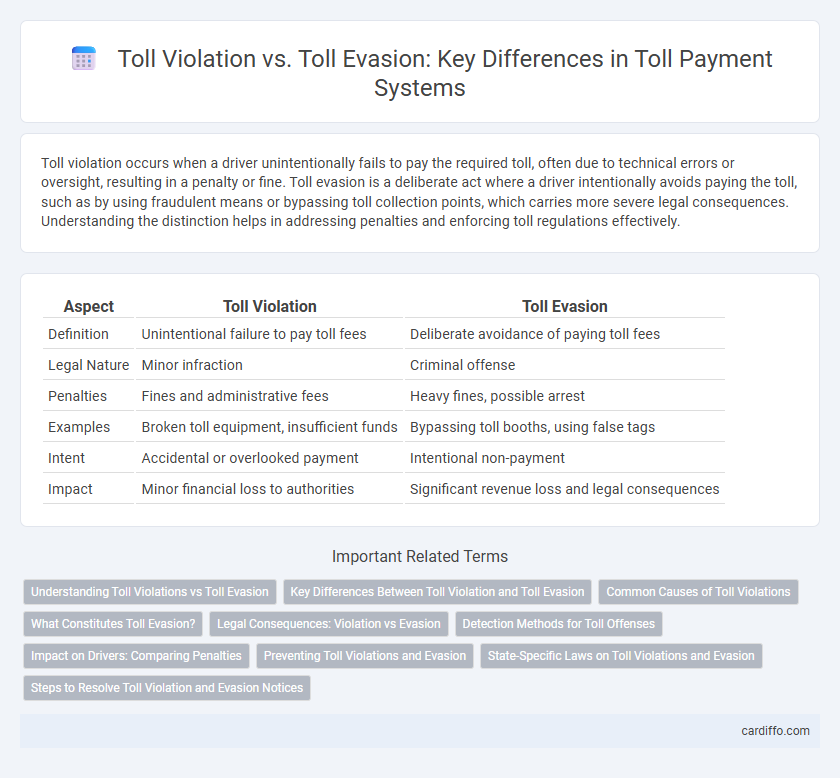Toll violation occurs when a driver unintentionally fails to pay the required toll, often due to technical errors or oversight, resulting in a penalty or fine. Toll evasion is a deliberate act where a driver intentionally avoids paying the toll, such as by using fraudulent means or bypassing toll collection points, which carries more severe legal consequences. Understanding the distinction helps in addressing penalties and enforcing toll regulations effectively.
Table of Comparison
| Aspect | Toll Violation | Toll Evasion |
|---|---|---|
| Definition | Unintentional failure to pay toll fees | Deliberate avoidance of paying toll fees |
| Legal Nature | Minor infraction | Criminal offense |
| Penalties | Fines and administrative fees | Heavy fines, possible arrest |
| Examples | Broken toll equipment, insufficient funds | Bypassing toll booths, using false tags |
| Intent | Accidental or overlooked payment | Intentional non-payment |
| Impact | Minor financial loss to authorities | Significant revenue loss and legal consequences |
Understanding Toll Violations vs Toll Evasion
Toll violations occur when drivers fail to pay the required toll fees, often due to accidental oversight or technical issues, resulting in fines or penalties. Toll evasion involves deliberate avoidance of toll payment, such as using counterfeit devices or deliberately bypassing toll booths, which can lead to criminal charges and higher fines. Understanding the difference is crucial for managing toll revenue and enforcing transportation laws effectively.
Key Differences Between Toll Violation and Toll Evasion
Toll violation occurs when a driver unintentionally fails to pay the toll due to errors such as malfunctioning transponders or incorrect vehicle information, whereas toll evasion involves deliberately avoiding toll payment through methods like using fake license plates or bypassing toll booths. Toll violations typically result in penalties or fines based on administrative errors, while toll evasion is treated as a serious legal offense with heavier fines and possible criminal charges. Understanding these distinctions is crucial for enforcing toll compliance and maintaining fair usage of toll roads.
Common Causes of Toll Violations
Common causes of toll violations include insufficient funds in the prepaid account, malfunctioning electronic transponders, and incorrect license plate information. Drivers often unintentionally bypass toll payments due to technical errors or missed toll booth signals. Frequent travel on unfamiliar toll roads without proper account setup also contributes significantly to unintentional toll violations.
What Constitutes Toll Evasion?
Toll evasion constitutes the deliberate act of avoiding payment for toll roads by using fraudulent methods such as disabling toll transponders, using counterfeit payment devices, or taking unauthorized routes to bypass toll points. Unlike toll violations, which are typically unintentional mistakes such as forgetting to pay or misreading toll signage, toll evasion involves intentional misconduct and legal penalties. Enforcement agencies prioritize detecting evasion through electronic toll collection systems and license plate recognition to maintain road maintenance funding.
Legal Consequences: Violation vs Evasion
Toll violation typically results in fines and penalties, as it is considered a failure to pay a toll within the required time frame. Toll evasion involves deliberate avoidance of toll payments and leads to more severe legal consequences, including higher fines, vehicle impoundment, and possible criminal charges. Courts treat evasion as a fraudulent act, thus imposing stricter enforcement measures compared to simple toll violations.
Detection Methods for Toll Offenses
Toll violation detection often relies on automated license plate recognition (ALPR) systems and electronic toll collection (ETC) data analysis to identify unpaid tolls. Toll evasion detection involves more advanced methods including surveillance cameras, vehicle tracking technology, and cross-referencing vehicle registration databases to catch deliberate attempts to avoid toll payments. Integration of real-time monitoring and machine learning algorithms enhances accuracy in distinguishing inadvertent violations from intentional evasion.
Impact on Drivers: Comparing Penalties
Toll violation typically results in fines and fees that are automatically billed to the driver, affecting their financial status without criminal charges. Toll evasion, classified as intentional avoidance, often incurs harsher penalties, including steeper fines, license suspension, and potential legal action. Drivers facing toll evasion charges experience more severe consequences, emphasizing the importance of compliance to avoid long-term impacts on driving records and insurance rates.
Preventing Toll Violations and Evasion
Preventing toll violations and evasion involves implementing advanced electronic toll collection systems, such as RFID tags and automatic license plate recognition, to ensure accurate toll payments. Enforcement measures include issuing fines and penalties through automated violation detection, deterring intentional evasion. Public awareness campaigns and clear signage also help educate drivers on toll regulations, reducing unintentional violations.
State-Specific Laws on Toll Violations and Evasion
State-specific laws on toll violations and toll evasion vary significantly across the U.S., with penalties ranging from fines to vehicle registration suspensions depending on the jurisdiction. Toll violations typically involve failing to pay tolls on time, often resulting in administrative fees, while toll evasion is classified as a deliberate act to avoid toll payment, carrying more severe legal consequences. Understanding these differences is essential for drivers transiting through states like Florida, California, and Texas, where enforcement and penalties are strictly implemented to deter toll evasion.
Steps to Resolve Toll Violation and Evasion Notices
Receiving a toll violation or toll evasion notice requires immediate action to avoid penalties and legal consequences. The first step involves carefully reviewing the notice for details such as date, time, location, and vehicle information to confirm its accuracy. Next, contact the issuing authority or toll agency to dispute errors, pay fines, or set up a payment plan, ensuring all communications and payments are documented for future reference.
Toll Violation vs Toll Evasion Infographic

 cardiffo.com
cardiffo.com